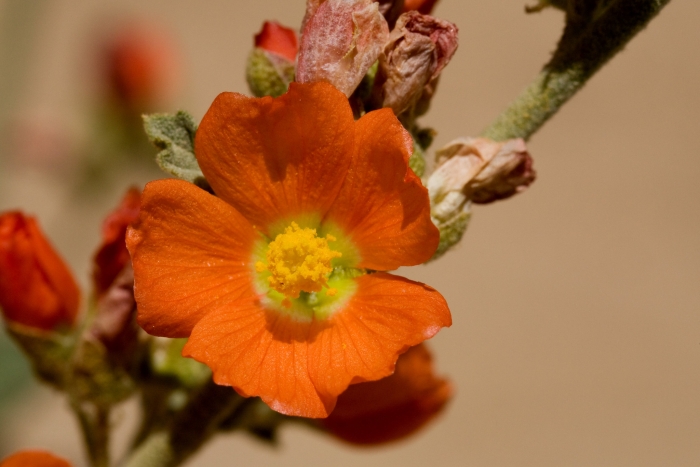Small-Leaf Globemallow
(Sphaeralcea parvifolia)
Small-Leaf Globemallow (Sphaeralcea parvifolia)
/
/

Patrick Alexander
CC0
Image By:
Patrick Alexander
Recorded By:
Copyright:
CC0
Copyright Notice:
Photo by: Patrick Alexander | License Type: CC0 | License URL: http://creativecommons.org/publicdomain/zero/1.0/deed.en | Uploader: Josve05a | Publisher: Wikimedia Commons |
















































Estimated Native Range
Summary
Sphaeralcea parvifolia, commonly known as Small-Leaf Globemallow, is a deciduous perennial subshrub or herb native to arid regions, including desert scrub, grasslands, and open woodlands in the Southwestern United States. It typically grows to a height and width of 2-3 feet (0.6-0.9 meters). This plant is characterized by its small, lobed leaves and stems covered with fine hairs, giving it a grayish appearance. The orange flowers, which bloom in the spring and summer, are cup-shaped and add a splash of color to the landscape. The flowers are moderately showy and attract pollinators such as bees and butterflies.
Small-Leaf Globemallow is valued for its drought tolerance and ability to thrive in challenging environments, making it an excellent choice for xeriscaping and naturalistic plantings in arid regions. It is also used in restoration projects to stabilize soils. In cultivation, it requires minimal maintenance, preferring full sun exposure and well-drained soils. While it tolerates poor soil conditions, it benefits from occasional watering during prolonged dry spells. There are no widely recognized cultivars of this species, but its natural form is well-suited to informal garden settings. Potential problems include root rot if overwatered and susceptibility to rust and other fungal diseases in humid conditions. It is not known to be invasive when grown outside its native range.CC BY-SA 4.0
Small-Leaf Globemallow is valued for its drought tolerance and ability to thrive in challenging environments, making it an excellent choice for xeriscaping and naturalistic plantings in arid regions. It is also used in restoration projects to stabilize soils. In cultivation, it requires minimal maintenance, preferring full sun exposure and well-drained soils. While it tolerates poor soil conditions, it benefits from occasional watering during prolonged dry spells. There are no widely recognized cultivars of this species, but its natural form is well-suited to informal garden settings. Potential problems include root rot if overwatered and susceptibility to rust and other fungal diseases in humid conditions. It is not known to be invasive when grown outside its native range.CC BY-SA 4.0
Plant Description
- Plant Type: Subshrub, Herb
- Height: 1.5-3 feet
- Width: 1.5-3 feet
- Growth Rate: Moderate
- Flower Color: Orange
- Flowering Season: Spring, Summer
- Leaf Retention: Deciduous
Growth Requirements
- Sun: Full Sun
- Water: Low
- Drainage: Fast
Common Uses
Bee Garden, Bird Garden, Drought Tolerant, Hummingbird Garden, Low Maintenance, Potted Plant, Showy Flowers
Natural Habitat
Native to arid regions, including desert scrub, grasslands, and open woodlands in the Southwestern United States
Other Names
Common Names: Smallflower Globemallow
Scientific Names: , Sphaeralcea parvifolia, Sphaeralcea marginata, Sphaeralcea arizonica,
GBIF Accepted Name: Sphaeralcea parvifolia A.Nelson